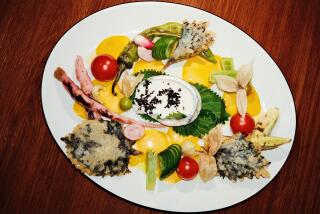THE BASTION OF BOUILLABAISSE
- Share via
MARSEILLE — “This, M’sieur, is a fish!” she said indignantly, as if the prospective buyer had questioned the virility of the finned fellow in question. She pointed to the sea behind her and said, “It has only just jumped out of the water.” Indeed, the shining scales were flashing in the sun and the tail was wiggling on the table.
This is not a pretty city, but what remains of the old Marseille can be found in the fish market that comes in with the tide every morning on the Quai des Belges. (By afternoon it has disappeared.) Blue-vested fishermen, caps pulled down to their eyes, stand with their rosy-cheeked wives. “Beyootifuul fish,” the women call, hugging their wares to their large bosoms. “Have you ever seen such beyootifuul fish?”
It is the very same fish you will find in the best of this city’s restaurants. There are restaurants boasting more stars and better service, but to my mind the only sensible reason to come to Marseille is for the raw shellfish, grilled whole fish--and, of course, the bouillabaisse.
The shellfish arrive on beds of seaweed-strewn ice; they are placed on regal thrones from which they can survey the table. There are glistening coral shrimp (to be dipped into green-hued homemade mayonnaise that has no peer), bristling sea urchins with their delicate orange roe, briny oysters and clams of all sizes. One of the brisk local rose wines helps these all slide down very easily.
Now a waiter brings a basket of fish and plunks it on the table. The colors are dazzling; he wants you to choose your dinner. The local fish are called sar , pageot , baudroie , daurade . . . . What does it matter what they are called? All are delicious. Whatever you choose will be grilled to a turn and brought to the table over burning branches of pine, served simply with boiled potatoes, whole lemons and some of the extraordinary local remoulade. Few foods are better.
Unless, of course, it is the bouillabaisse. “No,” said the waiter the first time I ordered this, “you cannot have six shrimp before the bouillabaisse. It is too much. I will bring you only three.” He was, of course, right--the bouillabaisse is a dish that requires fierce concentration.
Forget about everything you’ve ever tasted that went by that name. Here the waiter comes to the table with a trayful of whole cooked fish. He deftly bones each of them and puts the meat on a plate, surrounded by a few pieces of potato. Next he fetches a tureen filled with a glorious broth made of tomatoes and fish stock and spices with the single note of saffron singing out above the rest. He places a bowl of croutons at your elbow, another heaped with bright red rouille (made of olive oil, eggs, garlic and red pepper) and a third bowl filled with grated cheese. Now it is up to you.
You put some fish in your plate. You pile the rouille on the croutons, sprinkle some cheese over it and put the bread in the bowl. Then you ladle broth over all of it and wait a minute for the soup to soften the bread. Then you start all over again. People, myself among them, have been known to go on eating this for hours.
“You liked it!” said the waiter joyfully the first time that I distinguished myself by finishing everything. (This is not an easy feat.) He looked enormously content. “In Marseille, Madame,” he said proudly, “we know about fish.”
Two restaurants, owned by the same family, face each other across a single street; I think they are the best places to eat bouillabaisse. Calypso is slightly preferable because it is on the water. If you want to eat in the old port, the place to go is Miramar. All are quite simply appointed and quite expensive; expect to spend about $50 per person.
Calypso, 3 rue des Catalans, telephone 52.64.00.
Michel, 6 rue des Catalans, 52.64.22.
Miramar, 12 Quai du Port, 91.10.40 .
More to Read
Eat your way across L.A.
Get our weekly Tasting Notes newsletter for reviews, news and more.
You may occasionally receive promotional content from the Los Angeles Times.










